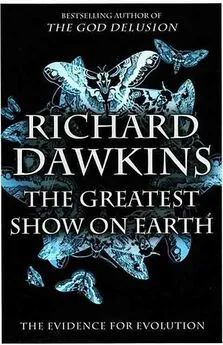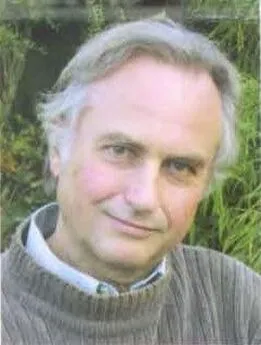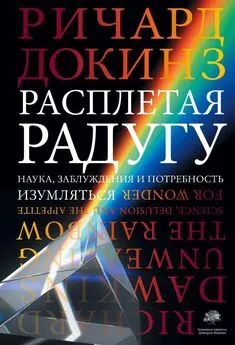Ричард Докинз - Рассказ предка. Паломничество к истокам жизни
- Название:Рассказ предка. Паломничество к истокам жизни
- Автор:
- Жанр:
- Издательство:Литагент «Corpus»47fd8022-5359-11e3-9f30-0025905a0812
- Год:2015
- Город:Москва
- ISBN:978-5-17-084589-7
- Рейтинг:
- Избранное:Добавить в избранное
-
Отзывы:
-
Ваша оценка:
Ричард Докинз - Рассказ предка. Паломничество к истокам жизни краткое содержание
Известный ученый-натуралист и популяризатор науки приглашает в грандиозное путешествие длиной в четыре миллиарда лет – к истокам жизни на Земле. По мере погружения в прошлое к нам, людям, присоединятся другие “пилигримы”, ищущие собственных прародителей. И тогда выяснится, что у нас общая история – и предки – не только с “сестрой цикадой” и “братом фазаном”, но и с растениями, грибами и бактериями, – со всеми организмами на планете.
Рассказ предка. Паломничество к истокам жизни - читать онлайн бесплатно ознакомительный отрывок
Интервал:
Закладка:
[135] Home, E. A description of the anatomy of the Ornithorhynchus paradoxus // Philosophical Transactions of the Royal Society of London 92 (1802): 67–84.
[136] Hou, X.-G., Aldridge, R. J., Bergstrom, J., et al. The Cambrian Fossils of Chengjiang, China: The flowering of Early Animal Life. Blackwell Science, Oxford, 2004.
[137] Huchon, D., Madsen, O., Sibbald, M. J. J. B., et al. Rodent phylogeny and a timescale for the evolution of Glires: Evidence from an extensive taxon sampling using three nuclear genes // Molecular Biology and Evolution 19 (2002): 1053–1065.
[138] Hume, D. The Natural History of Religion. ROOT, H. E., ED. Stanford University Press, Stanford, 1957/1757.
[139] Huxley, A. After Many a Summer. Chatto and Windus, London,
1939.
[140] Huxley, T. H. Man’s Place in Nature. Random House USA, New York, 2001/1836.
[141] Inoue, J. G., Masaki, M., Tsukamoto, К. & M. Nishida Basal actinopterygian relationships: A mitogenomicperspective on the phylogeny of the "ancient fish” // Molecular Phylogenetics and Evolution 26 (2003): 110–120.
[142] JEFFERY, W. R. & D. P MARTASIAN Evolution of eye regression in the caveflsh Astyanax: Apoptosis and the Pax-6 gene // American Zoology 38 (1998): 685–696.
[143] JERISON, H.J. Evolution of the Brain and Intelligence. Academic Press, New York, 1973.
[144] Jl, Q., Luo, Z.-X., Yuan, C.-X., ET AL. The earliest known euthe-rian mammal // Nature 416 (2002): 816–822.
[145] JOHANSON, D. C. & M. A. Edey Lucy: The Beginnings of Humankind. Grenada, London, 1981.
[146] JONES, S. The Language of the Genes: Biology, History, and the Evolutionary Future. HarperCollins, London, 1993.
[147] JuDSON, O. Dr. Tatiana’s Sex Advice to all Creation. Metropolitan Books, New York, 2002.
[148] Kauffman, S. a. Self-organization, selective adaptation, and its limits / In: Evolution at a Crossroads. DEPEW, D. J. & В. H. WEBER, eds. MIT Press, Cambridge, Mass., 1985. Pp. 169–207.
[149] KEELING, P J. & N. M. Fast Microsporidia: Biology and evolution of highly reduced intracellular parasites // Annual Review of Microbiology 56 (2002): 93-116.
[150] Kemp, T. S. Mammal-like reptiles and the origin of mammals. Academic Press, London, 1982.
[151] Kemp, T. S. The reptiles that became mammals // New Scientist 93 (1982): 581–584.
[152] KIMURA, M. Population Genetics, Molecular Evolution and the Neutral Theory. Takahata, N., ed. University of Chicago Press, Chicago, 1994.
[153] KINGDON, J. Island Africa. Collins, London, 1990.
[154] KINGDON, J. Lowly Origin. Where, When and Why our Ancestors First Stood Up. Princeton University Press, Princeton – Oxford, 2003.
[155] KINGSLEY, C. The Water Babies. Puffin, London, 1995/1863.
[156] KIPLING, R. Puck of Pook’s Hill. Penguin, London, 1995/1906.
[157] KiRSCHNER, M. S. & J. Gerhart Evolvability // Proceedings of the National Academy of Sciences of the USA 95 (1998): 8420–8427.
[158] KlTTLER, R., Kayser, M. & M. STONEKING Molecular evolution of Pediculus humanus and the origin of clothing // Current Biology
13 (2003): 1414–1417.
[159] KLEIN, R. G. The Human Career: Human Biological and Cultural Origins. 2nd ed. Chicago University Press, Chicago – London, 1999.
[160] KORTLANDT, A. New Perspectives on Ape and Human Evolution. Stichting voor Psychobiologie, Amsterdam, 1972.
[161] Krings, M., Stone, A., Schmitz, R. W, et al. Neanderthal DNA sequences and the origin of modern humans // Cell 90 (1997): 19–30.
[162] KRISTENSEN, R. M. An introduction to Loricifera, Cycliophora, and Micrognathozoa // Integrative and Comparative Biology 42 (2002): 641–651.
[163] Kruuk, H. Niko’s Nature. Oxford University Press, Oxford, 2003.
[164] Lack, D. Darwin’s Finches. Cambridge University Press, Cambridge,
1947.
[165] Lambourn, W A. The remarkable adaptation by which a dipterous pupa (Tabanidae) is preserved from the dangers of fissures in drying mud // Proceedings of the Royal Society of London: Series B 106 (1930): 83–87.
[166] Lang, B. F., O’Kelly, C., Nerad, T., et al. The closest unicellular relatives of animals // Current Biology 12 (2002): 1773–1778.
[167] LASKEY, R. A. & J. B. Gurdon Genetic content of adult somatic cells tested by nuclear transplantation from cultured cells // Nature 228 (197o): 1332–1334.
[168] LEAKEY, M. The hominid footprints: Introduction / In: Laetoli: A Pliocene Site in Northern Tanzania. LEAKEY, M. D. & J. M. HARRIS, EDS. Clarendon Press. Oxford, 1987. Pp. 490–496.
[169] Leakey, M., Feibel, C., McDougall, I. & A. Walker New four-million-year-old hominid species from Kanapoi and Allia Bay, Kenya // Nature 376 (1995): 565–571.
[170] Leakey, R. The Origin of Humankind. Basic Books, New York, 1994.
[171] LEAKEY, R. & R. LEWIN Origins Reconsidered: In Search of What Makes us Human . Little Brown, London, 1992.
[172] LEAKEY, R. & R. Lewin The Sixth Extinction: Biodiversity and its Survival. Weidenfeld & Nicolson, London, 1996.
[173] Lewis-Williams, D. The Mind in the Cave. Thames and Hudson, London, 2002.
[174] LEWONTIN, R. C. The apportionment of human diversity // Evolutionary Biology 6 (1972): 381–398.
[175] LlEM. K. F. Evolutionary strategies and morphological innovations: cichlid pharyngeal jaws // Systematic Zoology 22 (1973): 425–441.
[176] Littlewood, D. T. J., Smith, A. B., Clough, K. A. &
R. H. EMSON The interrelationships of the echinoderm classes: Morphological and molecular evidence // Biological Journal of the Linnean Society 61 (1997): 409–438.
[177] Liu, F. G. R., Miyamoto, M. M., Freire, N. P, et al. Molecular and morphological supertrees for eutherian (placental) mammals // Science 291 (2001): 1786–1789.
[178] LORENZ, K. Man Meets Dog. Routledge Classics, Routledge, London, 2002.
[179] Lovejoy, C. O. The origin of man // Science 211 (1981): 341–350.
[180] Luo, Z.-X., Cifelli, R. L. & Z. Kielan-Jaworowska Dual origin of tribosphenic mammals // Nature 409 (2001): 53–57.
[181] Manger, P R. & J. D. Pettigrew Electroreception and feeding behaviour of the platypus (Ornithorhychus anatinus: Monotrema: Mammalia) // Philosophical Transactions of the Royal Society of London: Biological Sciences 347 (1995): 359–381.
[182] Marcus, G. F. & S. E. Fisher FOXP2 in focus: what can genes tell us about speech and language? // Trends in Cognitive Sciences 7 (2003): 257–262.
[183] MARGULIS, L. Symbiosis in Cell Evolution. W H. Freeman, San Francisco, 1981.
[184] MARK Welch, D. & M. Meselson Evidence for the evolution of bdelloid rotifers without sexual reproduction or genetic exchange // Science 288 (2000): 1211–1219.
[185] MARTIN, R. D. Relative brain size and basal metabolic rate in terrestrial vertebrates // Nature 293 (1981): 57–60.
[186] Mash, R. How to Keep Dinosaurs. Weidenfeld & Nicholson, London, 2003/1983.
[187] Maynard Smith, J. The Evolution of Sex. Cambridge University Press, Cambridge, 1978.
[188] MAYNARD Smith, J. Evolution – contemplating life without sex // Nature 324 (1986): 300–301.
[189] Maynard Smith, J. & E. SzaTHMAry The Major Transitions in Evolution. Oxford University Press, Oxford, 1995.
[190] Mayr, E. The Growth of Biological Thought. Harvard University Press, Cambridge, Mass., 1985/1982.
[191] Medina, M., Collins, A. G., Silberman, J. D. & M. L. So-GIN Evaluating hypotheses of basal animal phylogeny using complete sequences of large and small subunit rRNA // Proceedings of the National Academy of Sciences of the USA 98 (2001): 9707–9712.
[192] Menotti-Raymond, M. & S.J. O’Brien Dating the genetic bottleneck of the African cheetah // Proceedings of the National Academy of Sciences of the USA 90 (1993): 3172–3176.
[193] MlLlUS, S. Bdelloids: No sex for over 40 million years // Science News 157 (2000): 326.
[194] Miller, G. The Mating Mind: How Sexual Choice Shaped the Evolution of Human Nature. Heinemann, London, 2000.
[195] MILLER, K. R. Finding Darwin’s God: A Scientist’s Search for Common Ground Between God and Evolution. Cliff Street Books (Harper Collins), New York, 1999.
[196] MILLER, K. R. The flagellum unspun: the collapse of “irreducible complexity” / In: Debating Design: From Darwin to DNA. RUSE, M. & W. Dembski, eds. Cambridge University Press, Cambridge, 2004.
[197] Mills, D. R., Peterson, R. L. & S. Spiegelman An extracellular Darwinian experiment with a self-duplicating nucleic acid molecule // Proceedings of the National Academy of Sciences of the USA 58 (1967): 217–224.
[198] MILNER, A. R. & S. E. K. Sequeira The temnospondylamphibians from the Visean of East Kirkton // Transactions of the Royal Society of Edinburgh, Earth Sciences 84 (1994): 331–361.
[199] MlYA, M., Takeshima, H., Endo, H., ET AL. Major patterns of higher teleostean phylogenies: A new perspective based on 100complete mitochondrial DNA sequences // Molecular Phylogenetics and Evolution 26 (2003): 121–138.
[200] MOLLON, J. D., BOWMAKER, J. K. & G. H. JACOBS Variations of colour vision in a New World primate can be explained by polymorphism of retinal photopigments // Proceedings of the Royal Society of London: Series B 222 (1984): 373–399.
[201] MONOD, J. Chance and Necessity: Essay on the Natural Philosophy of Modern Biology. Collins, London, 1972.
[202] MONTGELARD, C., BENTZ, S., TlRARD, C., ET AL. (2002) Molecular systematics of Sciurognathi (Rodentia): The mitochondrial cytochrome b and 12S rRNA genes support the Anomaluroidea (Pedetidae and Anomal-uridae) // Molecular Phylogenetics and Evolution 22 (1972): 220–233.
[203] Moreira, D., Le Guyader, H. & H. Philippe The origin of red algae and the evolution of chloroplasts // Nature 405 (2000): 32–33.
[204] MORGAN, E. The Aquatic Ape Hypothesis. Souvenir Press, London, 1997.
[205] MURATA, Y., Nikaido, M., Sasaki, T., ET AL. Afrotherianphy-logeny as inferred from complete mitochondrial genomes // Molecular Phylogenetics and Evolution 28 (2003): 253–260.
[206] Murdock, G. P Ethnographic Atlas. University of Pittsburgh Press, Pittsburgh, 1967.
[207] Murphy, W. J., Eizirik, E., O’Brien, S. J., et al. Resolution of the early placental mammal radiation using Bayesian phylogenetics // Science 294 (2001): 2348–2351.
[208] MUSSER, A. M. Review of the monotreme fossil record and comparison of palaeontological and molecular data // Comparative Biochemistry and Physiology Part A 136 (2003): 927–942.
[209] NELSON, J. S. Fishes of the World. 3rd ed. John Wiley, New York, 1994.
[210] NESSE, R. M. & G. C. WILLIAMS The Science of Darwinian Medicine. Orion, London, 1994.
[211] NlKOH, N., IWABE, N., Kuma, K.-I., ET AL. An estimate of divergence time of Parazoa and Eumetazoa and that of Cephalochordata and Vertebrata by aldolase and triosephosphate isomerase clocks // Journal of Molecular Evolution 45 (1997): 97-106.
[212] Nilsson, M. A., Gullberg, A., Spotorno, A. E., et al.
Читать дальшеИнтервал:
Закладка:




![Ричард Докинз - Река, выходящая из Эдема [Жизнь с точки зрения дарвиниста]](/books/1063750/richard-dokinz-reka-vyhodyachaya-iz-edema-zhizn-s-to.webp)

